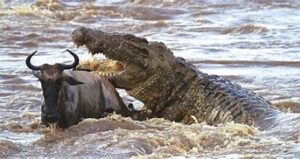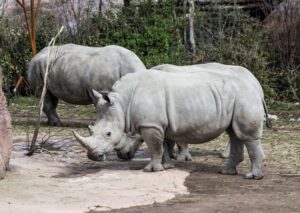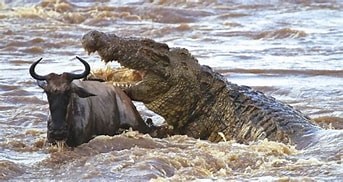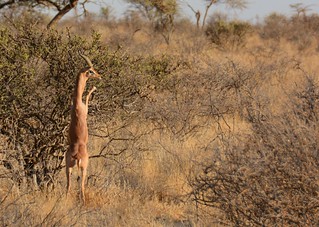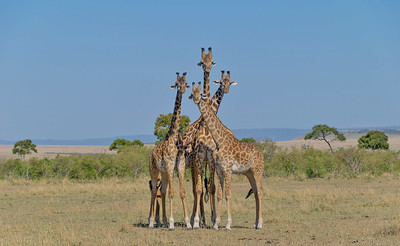The wildebeest great migration flow is the seasonal movement of hundreds of thousands of wildebeests, zebras, gazelles, elands, and impalas. They move from Serengeti in northwestern Tanzania to Masai Mara in southern Kenya. This is the largest wildlife migration on earth. This wildlife herd crosses the Mara River around July to August. They return to the South in Serengeti National Park around October to November. Therefore, the best times for watching this great migration will vary depending on your location.
Best time to see the wildebeest migration in Masai Mara – Great migration flow
Masai Mara National Reserve is an area of savannah wilderness preserved to conserve wildlife in southern Kenya along the Tanzanian border. Besides being known for the great wildebeest migration, Masai Mara is home to numerous wildlife. They live in this reserve throughout the year. Animals such as lions, cheetahs, elephants, zebras, and hippos among others. Therefore, this area can be visited throughout the year for wildlife viewing.
Wildebeest Migration – Great migration flow
The most anticipated sight in this area of course is the great wildebeest migration. This clockwise movement of approximately 1.5 million wildebeests is influenced by factors such as climate, pasture, mating as well as calving.
Best time to Visit (July to October)-Great migration flow
The best time to witness the wildebeest migration in the Masai Mara National Reserve is from July to October. During these months, the grasslands of Masai Mara are covered by wildebeests, zebras, and other herbivores. This migration can be seen on a game drive within the Masai Mara National Reserve. During this time of the year the vegetation is less thick and shorter, wildlife viewing is a lot easier and breathtaking.
In late July, the migration herds leave the Serengeti plains in search of water and food crossing the crocodile-infested Mara River into the Masai Mara plains. This is the best time to watch the dramatic river crossing. These wildebeest herds come face to face with the giant Nile crocodiles lying in the water as they await their prey.
In August, most of the wildebeests, zebras, gazelles, elands, and impalas arrive in the Masai mara along with other companions. Here, they will be welcomed by predators such as lions who will be looking to feast on them. This will result into a breathtaking predator-prey interaction. They will then settle in this region where they will enjoy peace and relaxation. This becomes the perfect time of year for a game drive safari in the Mara region.
Unfortunately, the time of the migration in this region coincides with the peak season. During which most travelers prefer to take a wildlife safari therefore expect to come across several tourists and queues of safari vehicles from time to time.
As October starts, the rains return, and the wildebeest herds start migrating back southwards to Serengeti National Park.
Best time to see the wildebeest migration in Serengeti
Serengeti National Park located in northern Tanzania is one of the destinations in Tanzania that make up the Northern tourist corridor. Just like Masai Mara, Serengeti National Park is home to numerous wildlife. Such wildlife includes lions, leopards, elephants, buffalo, black rhinos, and others. Therefore, a wildlife safari to Serengeti can be undertaken throughout the year.
This national park also makes up the other half of the cycle of the wildebeest migration hence making it a home for the wildebeest migration. The wildebeest herds star moving south of Serengeti during the months of May to July making it a perfect place to see the wildebeest migration at this time of year.
Calving season-Great migration flow
This migration starts with the calving of about 2 million wildebeests in the southern Serengeti. This birth of close to half a million calves takes place between the months of January and March. This draws several predators who come to feast on the newborns of herbivores. This creates a predator-prey interaction that result into a memorable sight for the visitors during this time.
Migration (May to July)
As the dry season of May approaches, the wildebeest herds, gazelles, and zebras along with their babies move northwards towards the Masai Mara in Kenya. By this time, the wildebeests have feasted on the short green grasses of the southern Serengeti. They have given birth to their offspring therefore ready for movement.
This movement will begin between April and early June during which the wildebeest herds will face their first obstacle, that is, crossing the Grumeti River. During this crossing, several animals do not survive as they are killed by the predators. Those that survive this will then continue northwards where they will cross the second obstacle, the Mara River. Those that cross the Mara River successfully continue into the grasslands of Masai Mara in Kenya. Here they enjoy food and pasture until October when they again prepare to move southwards.
Conclusion-Great migration flow
The great migration of wildebeest and other herbivores show the wildlife resilience to the environmental change and external factors. Their adaptability to the new requirement for their survival. It is summarized by two risky but a must do river crossing and the animal are willing to endure the difficult of crossing the rivers. They are chasing their goal of finding the new grazing and breeding areas. Make a date to witness this once in a lifetime activity, the timing of your trim will dictate which stage of migration you will witness but it is a year around activity.


